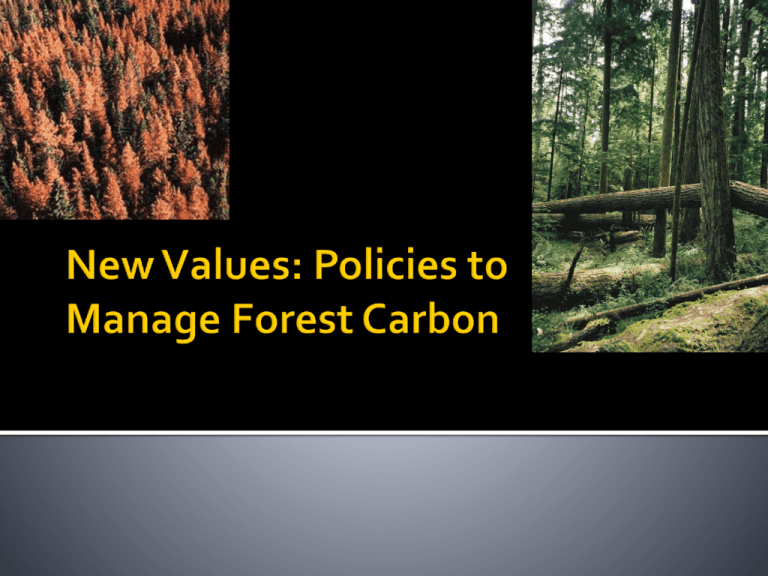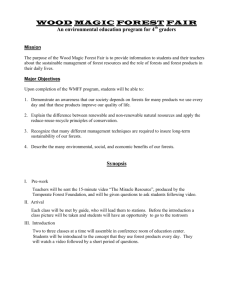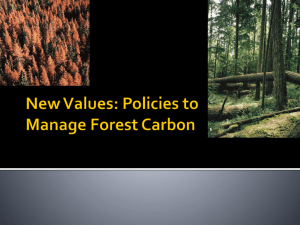Conclusions - FRST 523 – Forest and Environmental Policy
advertisement

November 12 - forest carbon 1, Tutorial 4 November 14 – carbon (cont) Brief due November 18 (Monday) – EBM simulation November 19 (Lecture) – comparative November 19 (evening) – area-based simulation November 21 – conclusion 1 November 26 – conclusion 2 November 28 – NO CLASS December 12 – 3:30-5:30 final exam November 12, 2013 2 November 12, 2013 3 legitimate reductions in GHGs that should, if properly regulated, play an meaningful role in climate policy or Sketchy subsidies that provide dubious contributions to reducing GHGs, and should not be including in sincere climate policies November 12, 2013 4 Emerging values Forest Carbon 100 How forests can contribute to GHG mitigation BC Climate policy General Forest carbon Policy Design Issues Promoting Wood Bioenergy (briefly) conclusion November 12, 2013 5 Ownership Rules for what counts Scope Including wood products Quantification Permanence Leakage Monitoring Additionality November 14, 2013 6 The project has to start after November 29, 2007 The project cannot be required by law or regulation. It must be demonstrated that the project faces financial, technological or other obstacles which are overcome, or partially overcome, by the incentive of being recognized as an emission offset The financial implications of the baseline scenario need to be considered Must be validated and by accredited 3rd party November 14, 2013 7 http://www.env.gov.bc.ca/cas/mitigation/pdfs/FCOP_final-dec7-overview.pdf 8 Afforestation Reforestation Improved forest management – examples: Conservation areas Increasing rotation age Increasing forest cover constraints (reduce harvest) Increase proportion of harvested wood products Conservation/avoided deforestation November 14, 2013 9 sequestration and storage of carbon in above- and below-ground parts of trees beyond what would occur under the baseline scenario No baseline established; project proponent proposes one for PCT approval November 14, 2013 10 Carbon stored November 14, 2013 11 http://www.dehst.de/SharedDocs/Bilder/EN/charts/chart_JICDM_Baseline.png?__blob=normal&v=3 November 14, 2013 12 Where a project changes the level of goods or services provide, causing a subsequent change to supply outside the area 2 types Land use shifting Harvest shifting 2 sources Internal leakage (lands controlled by project owner) External leakage – the broader market (not necessarily in same jurisdiction) November 14, 2013 13 55,000 ha private forest land in Kooteneys PCT description Bought by Nature Conservancy Canada NCC sold 450,ooo tonnes of credits to PCT November 14, 2013 14 “NCC carries out the stewardship of Darkwoods, resulting carbon being sequestered over time in addition to what would have happened in the absence of NCC’s conservation efforts. Had NCC not purchased the property, it likely would have been developed or logged at an intensive, “liquidation harvest,” level.” November 14, 2013 15 Baseline assumed to be harvesting 300,000 m3/yr NCC said it would log 10,000 per year, carbon in the remaining timber is the offset Actual harvesting rate 2001-07: 57,000 What appropriate baseline is uncertain November 14, 2013 16 November 14, 2013 17 November 14, 2013 18 Concern that carbon accounting outfits helping develop projects and those verifying project have a conflict of interest Government not being sufficient diligent in scrutinizing justification for project November 14, 2013 19 Attacks of incompetence from offseters Members of OAG audit team fired (uncertain whether related to case) Commitment by government to review PCT November 14, 2013 20 Big GBR carbon offset projects May be used to offset LNG expansion Challenges to additionality November 14, 2013 21 Emerging values Forest Carbon 100 How forests can contribute to GHG mitigation BC Climate policy General Forest carbon Policy Design Issues Promoting Wood bioenergy conclusion November 14, 2013 22 Wood First Act (Bill 9 – 2009) Sector wide initiative: Promote use of wood Framing: “wood is good” November 14, 2013 23 Through class participation November 14, 2013 24 Emerging values Forest Carbon 100 How forests can contribute to GHG mitigation BC Climate policy General Forest carbon Policy Design Issues Promoting Wood Bioenergy conclusion November 14, 2013 25 “convert wood waste and trees that have been killed by the mountain pine beetle into clean, renewable energy, create new opportunities for rural communities, spur new investment and innovation, and help B.C. become energy self-sufficient.” November 14, 2013 FRST 415 26 Viability depends on relative value of competing uses of forest stands Depends on Energy density Available technology (gathering and processing) Regulatory framework Relative prices of energy and competing forest products Sustainable Energy Policy 27 Mill residues Residues left in forest Standing timber (including plantation) November 14, 2013 28 From a greenhouse gas perspective, it makes more sense to use forests to make long-lived wood products Ben Parfitt – Managing BC’s Forests for a Cooler Planet Sustainable Energy Policy 29 BC’s forests can potentially contribute to greenhouse gas reductions, but immense complexity and uncertainty make effective and efficient policy design very difficult BC’s vast forest resource is a potentially significant source of energy, but the low energy density and costs of concentrating the resource where it can be processed means that for the foreseeable future it is likely to be a significant, economical source of energy only as a residual product of the forest sector. Sustainable Energy Policy 30 Apparent opportunities, immense challenges course tools applicable Emergent forest carbon policy Limited bioenergy policy Economics questionable November 14, 2013 FRST 415 31 Coming paradigm shift, or struggling industry grasping for faint hope? Depends in part on definition of rules What makes sense in terms of science? Beware of underlying interests November 14, 2013 FRST 415 32





